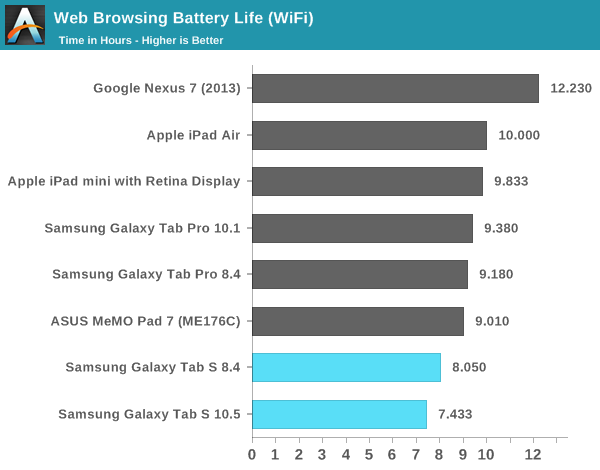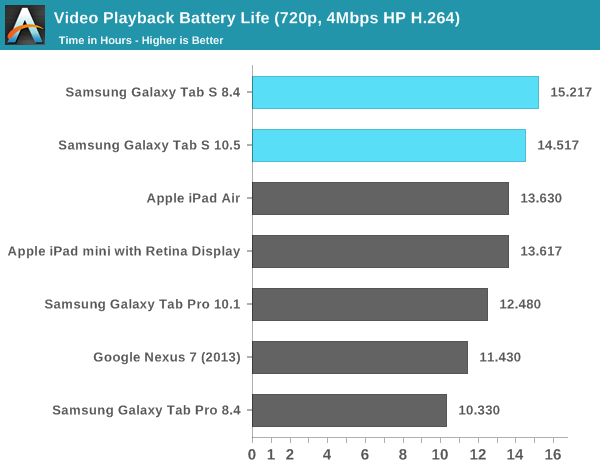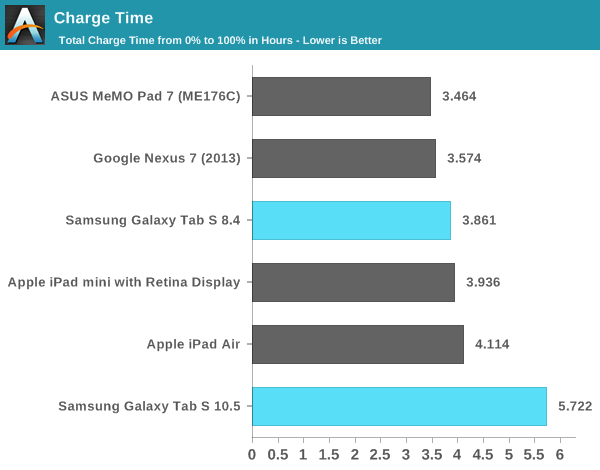Samsung Galaxy Tab S Review (10.5 & 8.4-inch)
by Anand Lal Shimpi on June 24, 2014 9:00 AM EST- Posted in
- Tablets
- Samsung
- Mobile
- Galaxy Tab S
Battery Life
Both Galaxy Tab Ses feature somewhat small batteries, a downside to pursuing a very thin chassis. The 10.5-inch model gets a 30Wh battery compared to 32.4Wh in the iPad Air, while the 8.4-inch model only has an 18.6Wh battery compared to 23.8Wh for the iPad mini with Retina Display.
For our web browsing workload, the battery size and power requirements of displaying mostly white web pages on a high resolution AMOLED display result in substandard battery life. Both devices deliver around 8 hours on a single charge, which isn’t bad in a vacuum - it’s just a regression compared to the Galaxy Tab Pro and far behind the other competition.

The story changes dramatically however once we look at video playback battery life:

Our video playback test is perfect for an AMOLED display as the final Harry Potter movie ends up having a lot of dark scenes in it. With only a small percentage of the display showing white, display power is reduced substantially, resulting in the best video playback battery life of any tablet we’ve ever tested. Even the tiny 8.4-inch Galaxy Tab S can last over 15 hours on a single charge.

Charge time isn’t particularly fast on any of the devices, but the 10.5-inch model in particular takes a while to make it to a full charge. The 10.5 will reach a 90% charge in just under 4 hours, but to make it to 97% takes another hour and the last 3% takes another 42 minutes on top of that. Usable charge time is competitive, but if you’re obsessive about always charging to 100% the 10.5-inch model does take a while to get there.










98 Comments
View All Comments
antiglobe - Sunday, October 26, 2014 - link
I think the updated model will more likely use the new Exynos used in Galaxy Alpha than a Snapdragon. Samsung can obviously reach higher profits by utilizing home made chips.the_ether - Tuesday, June 24, 2014 - link
So if I've understood correctly, the Samsung's screen isn't that great after all - at least when compared against the iPad Air. It has more pixels and supposedly better contrast (though that wasn't tested here) but what is displayed is not as accurate as the Air's Retina screen.nerd1 - Tuesday, June 24, 2014 - link
AMOLED has immense contrast and no display lag, both of which are not tested here.GC2:CS - Tuesday, June 24, 2014 - link
The smallest amount of ambient light washes out any contrast difference, so you can enjoy your AMOLED at night, especially watching horrors but otherwise it's hardly a problem.What about that display lag ? Honestly I don't know what it is exactly, but I think is rather bad as I noticed flickering on many AMOLED displays...
nerd1 - Tuesday, June 24, 2014 - link
Smallest amount of ambient light will hamper any display color accuracy too, then all displays are born equal?the_ether - Tuesday, June 24, 2014 - link
Shouldn't be as sensitive as you imply. The screen is an emissive device, not reflective, so the ambient light would have to be strong enough to interfere with the light from the screen.theduckofdeath - Tuesday, June 24, 2014 - link
Hyperbole much, GC2:CS?dwade123 - Wednesday, June 25, 2014 - link
no lag huh. Nice BS.GC2:CS - Tuesday, June 24, 2014 - link
Yeah exactly ! The problem for samsung is that the iPad Air screen is the same as the screen of the new iPad (2012) just lower power and higher brightness... And this is 2014. Anand's numbers are painting these in a very good picture, but in reality I found this: https://m.youtube.com/watch?v=SjYuNzFRIagBlues are especially over saturated on the 10,5 just as that horrible sub pixel arrangement implies.
bji - Tuesday, June 24, 2014 - link
How can you possibly tell anything about a display when viewing a video of it on your own display, which completely alters the perceived characteristics of the display being evaluated?I have an idea. Let's film both displays in black and white and then do a comparison to try to see which display has better colors. It would be just about as viable a means of comparing displays as the video you linked.